-
 Bitcoin
Bitcoin $86,250.6982
1.63% -
 Ethereum
Ethereum $1,890.1026
-0.98% -
 Tether USDt
Tether USDt $1.0000
0.01% -
 XRP
XRP $2.1367
0.29% -
 BNB
BNB $603.5934
-0.76% -
 Solana
Solana $129.4201
2.45% -
 USDC
USDC $1.0000
0.00% -
 Dogecoin
Dogecoin $0.1724
0.45% -
 Cardano
Cardano $0.6839
0.62% -
 TRON
TRON $0.2381
0.57% -
 Toncoin
Toncoin $3.9840
-0.47% -
 Chainlink
Chainlink $13.8431
-2.30% -
 UNUS SED LEO
UNUS SED LEO $9.3956
0.41% -
 Stellar
Stellar $0.2705
-1.46% -
 Avalanche
Avalanche $19.2650
-0.80% -
 Sui
Sui $2.4309
0.03% -
 Shiba Inu
Shiba Inu $0.0...01260
-0.64% -
 Hedera
Hedera $0.1716
0.58% -
 Polkadot
Polkadot $4.1457
-0.42% -
 Litecoin
Litecoin $85.5964
0.72% -
 Bitcoin Cash
Bitcoin Cash $308.6728
-0.07% -
 MANTRA
MANTRA $6.3356
0.99% -
 Bitget Token
Bitget Token $4.5842
-0.52% -
 Dai
Dai $0.9997
-0.04% -
 Ethena USDe
Ethena USDe $0.9999
0.01% -
 Hyperliquid
Hyperliquid $13.7596
4.34% -
 Pi
Pi $0.6794
-3.81% -
 Monero
Monero $219.4683
1.07% -
 Uniswap
Uniswap $6.1878
-0.70% -
 Aptos
Aptos $5.3777
0.02%
What does blockchain mining mean? What is the difference between PoW and PoS mining?
Blockchain mining validates transactions and secures networks, with PoW requiring high energy and PoS being more efficient but facing centralization challenges.
Apr 01, 2025 at 10:07 pm
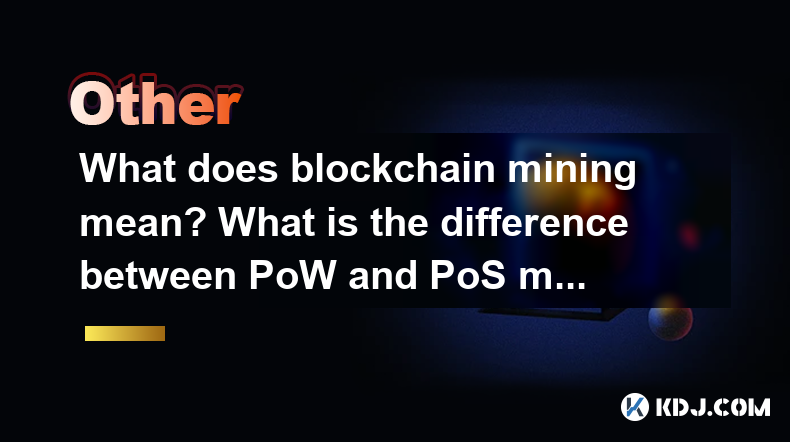
What is Blockchain Mining?
Blockchain mining is a crucial process in the world of cryptocurrencies, serving as the backbone for maintaining and securing blockchain networks. At its core, mining involves solving complex mathematical problems to validate transactions and add them to the blockchain. This process not only ensures the integrity and security of the network but also introduces new coins into circulation. Miners, the individuals or entities performing this task, are rewarded with these new coins and transaction fees, incentivizing them to continue their efforts. The concept of mining originated with Bitcoin and has since been adopted by numerous other cryptocurrencies.
How Does Blockchain Mining Work?
Blockchain mining operates on the principle of consensus mechanisms, which are protocols that ensure all participants in the network agree on the state of the blockchain. The most common consensus mechanisms are Proof of Work (PoW) and Proof of Stake (PoS). In PoW, miners compete to solve cryptographic puzzles, and the first to solve it gets to add a new block to the blockchain. This process requires significant computational power and energy. In contrast, PoS selects validators based on the number of coins they hold and are willing to "stake" as collateral, which is less energy-intensive.
The Role of Miners in the Blockchain Ecosystem
Miners play a vital role in the blockchain ecosystem by validating transactions and maintaining the network's security. Without miners, transactions would not be verified, and the blockchain would be vulnerable to attacks. Miners are essentially the guardians of the blockchain, ensuring that only legitimate transactions are added to the ledger. Their efforts also help to decentralize the network, preventing any single entity from gaining control over the blockchain. This decentralization is a fundamental aspect of cryptocurrencies, promoting trust and security among users.
Proof of Work (PoW) Mining Explained
Proof of Work (PoW) is the original consensus mechanism used by Bitcoin and many other cryptocurrencies. In PoW mining, miners compete to solve complex mathematical problems, known as hash functions. The first miner to solve the problem gets to add a new block to the blockchain and is rewarded with newly minted coins and transaction fees. This process requires significant computational power, as miners need powerful hardware, such as ASICs (Application-Specific Integrated Circuits), to solve these problems quickly. The difficulty of these problems adjusts periodically to maintain a consistent block time, ensuring the network's stability.
The Energy Consumption of PoW Mining
One of the major criticisms of PoW mining is its high energy consumption. The process requires vast amounts of electricity to power the mining hardware, leading to concerns about its environmental impact. Some estimates suggest that Bitcoin mining alone consumes as much electricity as entire countries. This has led to calls for more sustainable alternatives, such as PoS. However, proponents of PoW argue that the energy consumption is a necessary trade-off for the security and decentralization it provides. They also point out that miners often use renewable energy sources to offset their environmental footprint.
Proof of Stake (PoS) Mining Explained
Proof of Stake (PoS) is an alternative consensus mechanism that aims to address the energy consumption issues associated with PoW. In PoS, validators are chosen to create new blocks based on the number of coins they hold and are willing to "stake" as collateral. This process is less energy-intensive, as it does not require solving complex mathematical problems. Instead, validators are selected through a random process, with the probability of selection increasing with the size of their stake. PoS is used by cryptocurrencies like Ethereum (after its transition to Ethereum 2.0) and Cardano, among others.
The Advantages of PoS Mining
PoS mining offers several advantages over PoW. Firstly, it is significantly more energy-efficient, making it a more sustainable option for blockchain networks. Secondly, PoS is less susceptible to centralization, as it does not favor those with the most powerful hardware. Instead, it rewards those who hold the most coins, promoting a more democratic distribution of mining power. Additionally, PoS can lead to faster transaction processing times and lower fees, as the validation process is less resource-intensive. These advantages have led to a growing adoption of PoS among new and existing cryptocurrencies.
The Challenges of PoS Mining
Despite its advantages, PoS mining also faces several challenges. One of the main concerns is the potential for "nothing at stake" attacks, where validators could vote for multiple blockchain forks to maximize their rewards. To mitigate this, PoS systems often implement penalties for malicious behavior, such as slashing a portion of the staked coins. Another challenge is the initial distribution of coins, as PoS can favor early adopters who hold large amounts of the cryptocurrency. This can lead to centralization if not managed properly. Additionally, the transition from PoW to PoS can be complex and time-consuming, as seen with Ethereum's ongoing upgrade to Ethereum 2.0.
Comparing PoW and PoS Mining
When comparing PoW and PoS mining, several key differences emerge. PoW requires significant computational power and energy, while PoS is more energy-efficient and less resource-intensive. PoW is more secure against certain types of attacks, such as 51% attacks, but it can lead to centralization due to the high cost of mining hardware. PoS, on the other hand, is less susceptible to centralization but faces challenges like "nothing at stake" attacks. Both mechanisms have their strengths and weaknesses, and the choice between them often depends on the specific goals and values of the blockchain network.
The Future of Blockchain Mining
The future of blockchain mining is likely to see continued innovation and evolution. As concerns about energy consumption grow, more networks may transition to PoS or explore other consensus mechanisms, such as Proof of Capacity (PoC) or Proof of Burn (PoB). Additionally, advancements in technology, such as the development of more energy-efficient mining hardware, could help mitigate the environmental impact of PoW. The ongoing debate between PoW and PoS will likely shape the direction of blockchain technology, with each network choosing the mechanism that best aligns with its goals and values.
Common Questions About Blockchain Mining
Q: What is the primary purpose of blockchain mining?
A: The primary purpose of blockchain mining is to validate transactions and add them to the blockchain, ensuring the network's security and integrity. Miners are rewarded with new coins and transaction fees for their efforts.
Q: How does Proof of Work (PoW) mining work?
A: In PoW mining, miners compete to solve complex mathematical problems. The first miner to solve the problem gets to add a new block to the blockchain and is rewarded with newly minted coins and transaction fees. This process requires significant computational power and energy.
Q: What are the main advantages of Proof of Stake (PoS) mining?
A: PoS mining is more energy-efficient, less susceptible to centralization, and can lead to faster transaction processing times and lower fees. It rewards validators based on the number of coins they hold and are willing to stake as collateral.
Q: What are the main challenges of PoS mining?
A: The main challenges of PoS mining include the potential for "nothing at stake" attacks, the initial distribution of coins favoring early adopters, and the complexity of transitioning from PoW to PoS.
Q: How do PoW and PoS mining differ in terms of energy consumption?
A: PoW mining requires significant energy to power the mining hardware, leading to high energy consumption. PoS mining, on the other hand, is much more energy-efficient, as it does not require solving complex mathematical problems.
Q: Can a blockchain network switch from PoW to PoS?
A: Yes, a blockchain network can switch from PoW to PoS, but the transition can be complex and time-consuming. Ethereum's ongoing upgrade to Ethereum 2.0 is an example of such a transition.
Q: What is the role of miners in maintaining the security of a blockchain network?
A: Miners play a crucial role in maintaining the security of a blockchain network by validating transactions and adding them to the blockchain. Their efforts help to prevent fraudulent transactions and ensure the network's integrity.
Q: How does the difficulty of PoW mining problems affect the network?
A: The difficulty of PoW mining problems adjusts periodically to maintain a consistent block time. If the difficulty is too low, blocks are added too quickly, and if it's too high, blocks are added too slowly. This adjustment ensures the network's stability and security.
Q: What is the environmental impact of PoW mining?
A: PoW mining has a significant environmental impact due to its high energy consumption. Some estimates suggest that Bitcoin mining alone consumes as much electricity as entire countries. This has led to concerns about its sustainability and calls for more energy-efficient alternatives.
Q: How does PoS mining promote decentralization?
A: PoS mining promotes decentralization by rewarding validators based on the number of coins they hold, rather than their computational power. This prevents the concentration of mining power in the hands of those with the most powerful hardware, leading to a more democratic distribution of mining power.
Disclaimer:info@kdj.com
The information provided is not trading advice. kdj.com does not assume any responsibility for any investments made based on the information provided in this article. Cryptocurrencies are highly volatile and it is highly recommended that you invest with caution after thorough research!
If you believe that the content used on this website infringes your copyright, please contact us immediately (info@kdj.com) and we will delete it promptly.
- Grayscale Launches Two New Bitcoin ETFs: BTCC and BPI
- 2025-04-03 02:05:12
- Bitcoin (BTCUSD) Has Been on an Upward Trajectory Despite Volatility in Crypto and Traditional Markets
- 2025-04-03 02:05:12
- Ripple Integrates Its USD-Backed Stablecoin to Cross-Border Payments System
- 2025-04-03 02:00:12
- Dogecoin (DOGE) Forms Inverse H&S Pattern, Presenting Immediate Breakout Targets
- 2025-04-03 02:00:12
- Retesting the 61.8% Fibonacci Retracement Level Could Be a Defining Moment for the SOL/USD Pair
- 2025-04-03 01:55:13
- Ozak AI (OZ) Could Be the Next 1000x Gainer, Not Gold
- 2025-04-03 01:55:13
Related knowledge
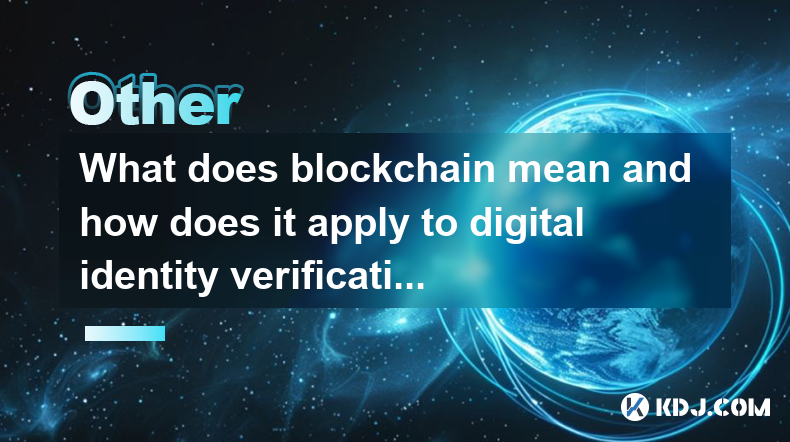
What does blockchain mean and how does it apply to digital identity verification?
Apr 03,2025 at 02:21am
Blockchain technology, at its core, is a decentralized and distributed digital ledger used to record transactions across numerous computers. This ensures that the recorded data cannot be altered retroactively without the alteration of all subsequent blocks and the consensus of the network. The concept of blockchain was initially devised for the digital ...
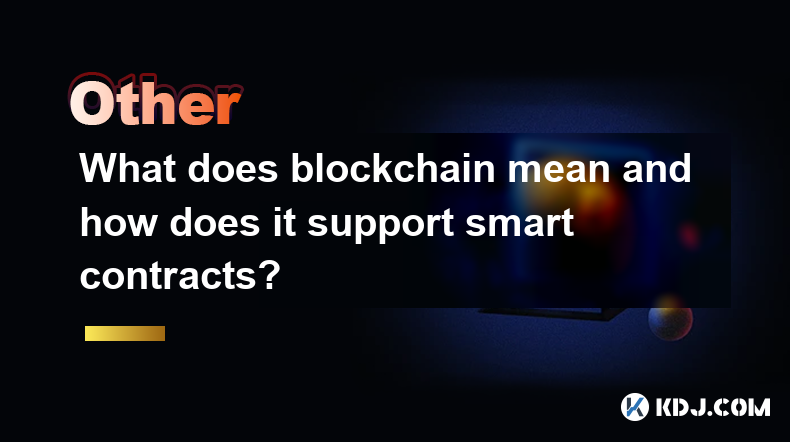
What does blockchain mean and how does it support smart contracts?
Apr 03,2025 at 02:28am
Blockchain technology is a decentralized, distributed ledger that records transactions across numerous computers. It ensures that once data is recorded, it cannot be altered retroactively without the alteration of all subsequent blocks and the consensus of the network. This technology is the backbone of cryptocurrencies like Bitcoin and Ethereum. Blockc...
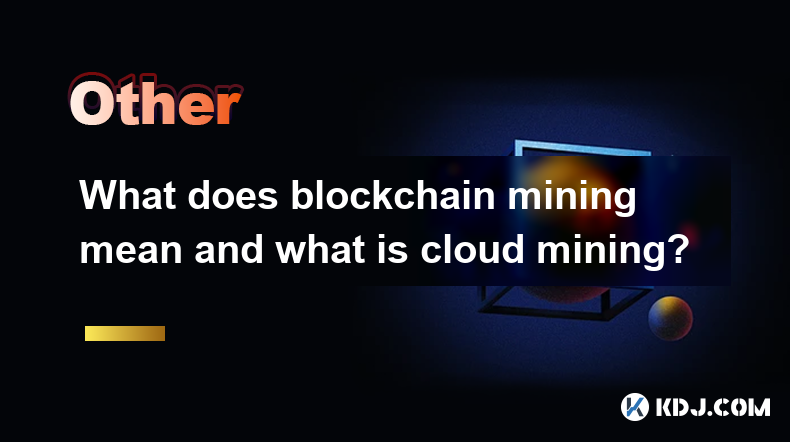
What does blockchain mining mean and what is cloud mining?
Apr 03,2025 at 02:01am
Blockchain mining is the process by which new transactions are verified and added to the blockchain ledger. It involves solving complex mathematical problems using computational power, which results in the creation of new cryptocurrency units as a reward. Miners compete to solve these problems, and the first one to find the solution gets to add a new bl...
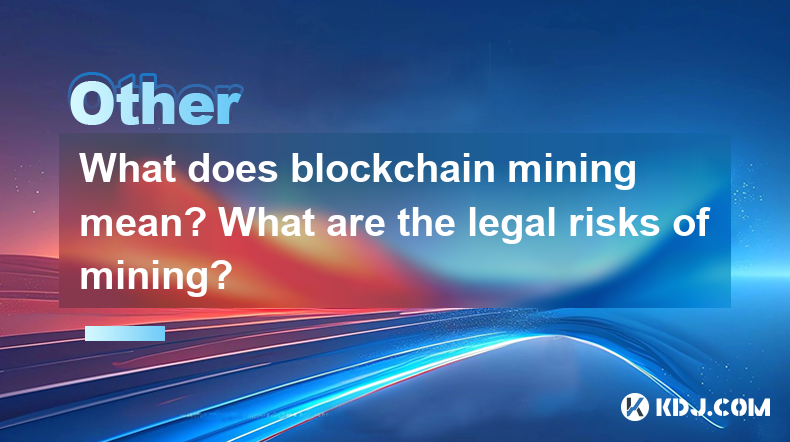
What does blockchain mining mean? What are the legal risks of mining?
Mar 31,2025 at 05:07pm
Blockchain mining is the process by which transactions are verified and added to the public ledger, known as the blockchain. Miners use powerful computers to solve complex mathematical problems, which, once solved, allow them to add a block of transactions to the blockchain. In return, miners are rewarded with cryptocurrency, typically Bitcoin. This pro...
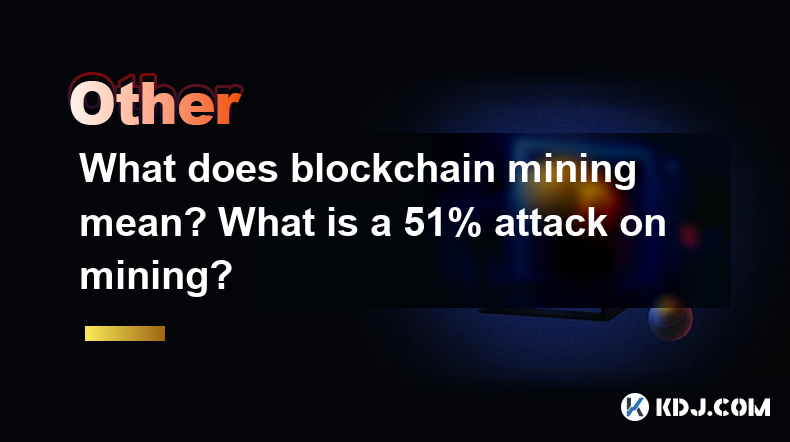
What does blockchain mining mean? What is a 51% attack on mining?
Apr 02,2025 at 03:28am
Blockchain mining is a critical process in the world of cryptocurrencies, particularly those that use proof-of-work (PoW) consensus mechanisms like Bitcoin. Mining involves using computational power to solve complex mathematical puzzles, which, when solved, validate and add new transactions to the blockchain. Miners are incentivized to participate throu...
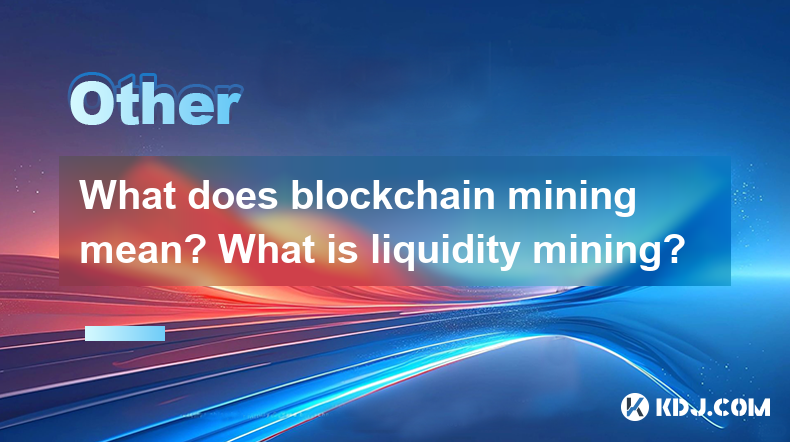
What does blockchain mining mean? What is liquidity mining?
Apr 01,2025 at 12:07am
What is Blockchain Mining?Blockchain mining is a critical process in the world of cryptocurrencies, particularly for networks like Bitcoin and Ethereum. It involves the use of computational power to solve complex mathematical problems, which in turn validates transactions and adds them to the blockchain. Miners are incentivized through rewards, typicall...

What does blockchain mean and how does it apply to digital identity verification?
Apr 03,2025 at 02:21am
Blockchain technology, at its core, is a decentralized and distributed digital ledger used to record transactions across numerous computers. This ensures that the recorded data cannot be altered retroactively without the alteration of all subsequent blocks and the consensus of the network. The concept of blockchain was initially devised for the digital ...

What does blockchain mean and how does it support smart contracts?
Apr 03,2025 at 02:28am
Blockchain technology is a decentralized, distributed ledger that records transactions across numerous computers. It ensures that once data is recorded, it cannot be altered retroactively without the alteration of all subsequent blocks and the consensus of the network. This technology is the backbone of cryptocurrencies like Bitcoin and Ethereum. Blockc...

What does blockchain mining mean and what is cloud mining?
Apr 03,2025 at 02:01am
Blockchain mining is the process by which new transactions are verified and added to the blockchain ledger. It involves solving complex mathematical problems using computational power, which results in the creation of new cryptocurrency units as a reward. Miners compete to solve these problems, and the first one to find the solution gets to add a new bl...

What does blockchain mining mean? What are the legal risks of mining?
Mar 31,2025 at 05:07pm
Blockchain mining is the process by which transactions are verified and added to the public ledger, known as the blockchain. Miners use powerful computers to solve complex mathematical problems, which, once solved, allow them to add a block of transactions to the blockchain. In return, miners are rewarded with cryptocurrency, typically Bitcoin. This pro...

What does blockchain mining mean? What is a 51% attack on mining?
Apr 02,2025 at 03:28am
Blockchain mining is a critical process in the world of cryptocurrencies, particularly those that use proof-of-work (PoW) consensus mechanisms like Bitcoin. Mining involves using computational power to solve complex mathematical puzzles, which, when solved, validate and add new transactions to the blockchain. Miners are incentivized to participate throu...

What does blockchain mining mean? What is liquidity mining?
Apr 01,2025 at 12:07am
What is Blockchain Mining?Blockchain mining is a critical process in the world of cryptocurrencies, particularly for networks like Bitcoin and Ethereum. It involves the use of computational power to solve complex mathematical problems, which in turn validates transactions and adds them to the blockchain. Miners are incentivized through rewards, typicall...
See all articles
























































































